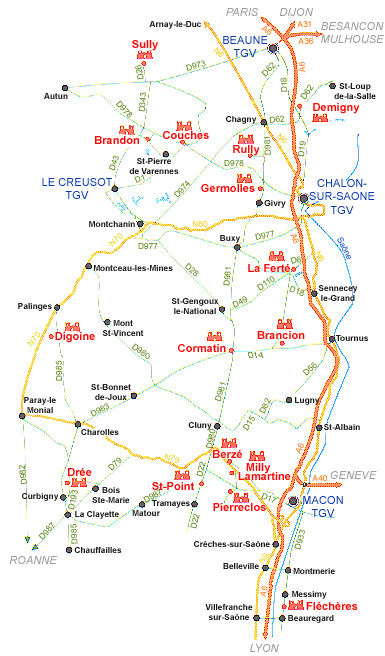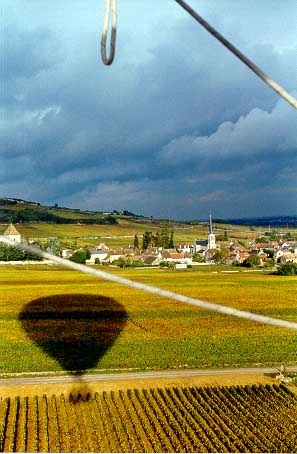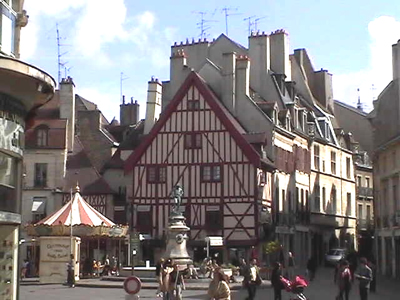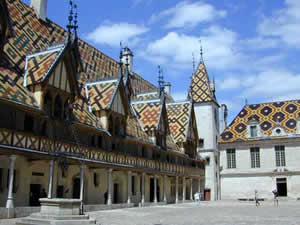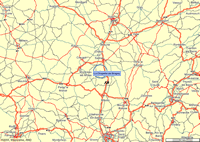| L'Arcane... The Hidden Mystery of Burgundy | ||||||
|
||||||
ATTRACTIONS The Castles - Ballooning - Cycling - Canalside - Dijon - Beaune - Chalon - Neighboring Cities - Useful Links
Place your mouse over each of the castles (in red) to read a quick description. Chateau de Brancion: http://www.brancion.fr
Your hosts will give you directions to one of France's longest bicycle paths. Travel through vineyards south of the ruins of Cluny and back north to Nuits St Georges. Tiny villages, manor farms, and millhouses, exquisite parish churches are the rural soul of Burgundy. From Dijon to Beaune and Chagny, along the Burgundy Wine Route or "Route du Vin," famous since the Gallo-Roman era. The path runs through the heart of the vineyards of the "Côte d'Or" wine country. Famous wines from: Gevrey-Chambertin, Clos -Vougeot, Vosne-Romanee, Pommard, Meusault, and more. Stop along the way for a taste, a meal, and even ship your bottles home! Wide Open Road Cycling: http://www.wideopenroad.co.uk/BJ1.html
Saône-et-Loire, is the part of Burgundy that has a lot to offer with its 300 kilometers of waterways, its numerous Roman churches, its castles, its Charolais cattle (white cows), its water mills and poultry of Burgundian Bresse. This dramatic waterway is a part of an ancient route linking the Atlantic to the Mediterranean sea. The building process for the Burgundy Canal took over 200 years, starting in 1607 and ending in 1832. Burgundy Canal: http://www.burgundy-canal.com/index.html
Called the Owl’s Trail, the tour directs you along arrows painted on the sidewalks, and an owl painted on a sidewalk marks a sightseeing spot on the map . The trail leads down Rue des Forges past the tourist office toward the ducal palace. Before reaching the palace, it turns left and leads to Notre-Dame, the gargoyle-adorned 13th century church. From the front of the church, walk down the lane on the left side. Here is the owl that gives the trail its name. Carved into the church by an unknown sculptor, the owl is a trademark of the city. Rub it with your left hand, the nearest to the heart, and it is supposed to bring good luck. Farther on is the Maison Millière, a 15th century half-timbered house used as a setting in numerous movies, including “Cyrano de Bergerac.” Nearby, the half-timbered houses on rue Verrerie are home to the city’s antique dealers. The street is named for the glassmakers once located there, but it has also been known by a couple of other colorful names like Rue du Marché-aux-Porcs (pig market), Rue du Sargis (woolen cloth) and later Rue des Tondeurs (shearers). If you are still following the Owl’s Trail, you now come to the Place du Theatre. Although the theater with its columns is an imposing structure, the main sights here are the former abbey Church of St.-Etienne and St. Michael’s church. The former houses the chamber of commerce and the Musée Rude, which honors local sculptor Francois Rude, while the latter is a towering gothic and renaissance masterpiece built between the 15th and 17th centuries. Like many European palaces, le "Palais des Ducs et des États de Bourgogne" started as a rather modest medieval structure, and just kept growing. Today it houses Dijon’s City Hall and the Museum of Fine Arts. The museum, which is considered one of France’s best, features art from the 14th to 20th centuries. Here are also the tombs of Philip the Bold and John the Fearless. The tombs of the Dukes of Burgundy will leave you speechless. The details are simply incredible. Other sights within the palace compound include the Tour de Bar, a tower where Good King René, Duke of Anjou, Bar and Lorraine and King of Hungary, Jerusalem and Sicily was imprisoned in 1431 for four years. It is the oldest part of the palace. Check out the 150-foot Philippe le Bon tower. It offers a good view of Dijon. The Cathedral of St. Bénigne was once the chapel of a benedictine monastery. The crypt dates to around 1000AD, and is considered a masterpiece of Burgundy romanesque architecture. The whole cathedral is an eclectic mix of architecture, with a gothic chancel and nave, a Romanesque rotunda and a 19th-century spire, along with its colorful patterned roof tiles. Next door to St. Bénigne is the Musée Archéologique, housed in the dormitory of the former benedictine abbey. Here the city’s history is on display, with artifacts dating back to the Bronze and Iron Ages, the Gallo-Roman period and medieval times. From here it is only a block to Place Darcy, past the mustard museum, where the tourist office is located, with its 18th-century triumphal arch, the Porte Guillaume, and the shade of the Jardin Darcy.
The Birthplace of Photography Chalon-sur-Saône is a wonderful town considered a crossroad for fluvial traffic. Of the 6,000 boats that visit every year - 5,000 of these are pleasure cruises. Some are large "hotel" boats holding over 100 guests - others are small private canal barges. Known for its charming old "centre ville" (downtown), shops, wine tasting, restaurants and cafésm, you'll be happy you stopped by. Its claim to fame is Nicéphore Niépce, born there in 1765. He dedicated his life to science. In 1816 he captured for the first time "a real point of view" in a darkroom. In 1826 he named his invention "Heliography". He went on to invent photography, photogravure and worked with his brother Claude Niépce on one of the first internal combustion engines. He died in 1833. The Museum Nicéphore Niépce is a place that captures the essence of the birth of photography and is unique in Europe. You can see the first camera, a history of photography which covers historical, technical,artistic aspects and so much more. Chalon-sur-Saône: http://www.mairie-chalon-sur-saone.fr/
Burgundy is one of the central regions of France, making it a crossroad for neighboring cities and for other European countries. Why not plan a 1-2 days trip to some of these cities? Click on the map below to enlarge it and see the larger cities in a 100-200km radius. North West: Nevers
- Gites de France (Guest Houses of France)
|
||||||
L'Arcane © Copyright 2004-2010 - Astral Marketing - All Rights Reserved |
